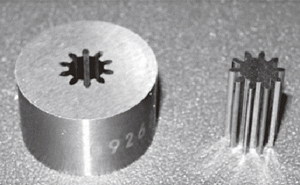New intermetallic hard material binder phase developed for cemented carbides
There are a number of reasons for the cemented carbide (hardmetals) industry continuing to search for an alternative binder element to cobalt in the production of WC-Co wear parts and cutting tools. These include the sensitivity of cobalt metal to extreme price fluctuations, the need to develop hardmetal alloys with ever high mechanical properties and improved erosion-corrosion resistance, and the health and safety aspects of WC-Co breathable dust mixtures during processing. Some success has already been achieved with binders based on FeCoNi, NiCr, and NiCrFe, but now researchers in the Materials Research Institute for Sustainable Development, Agency of Industrial Science (AIST), in Nagoya, Japan, have come up with a new concept using an Fe-Al aluminide intermetallic compound as a binder.

Fig.1 Process for producing newly developed WC-FeAl cemented carbide hard materials (as published in Synthesiology Vol.3, No.4, 2011, 290-298)
Keizo Kobayashi* and his colleagues at AIST first followed the conventional route for producing cemented carbides utilizing the new Fe-Al intermetallic binder. This involved wet-mixing WC, Fe and Al powders by attrition ball milling followed by consolidation and vacuum sintering at 1440C. High temperature sintering was felt to be necessary in order to increase the adherence (wetting) of the FeAl binder phase to the WC particles.
The researchers stated that the resulting WC-FeAl material showed excellent resistance to oxidation, even when heated to 800C in air, and when the material was HIPped the bending strength reached a maximum of 1.8 GPa – close to the goal of 2 GPa the researchers had set themselves. However, it proved impractical to manufacture stable compacts because the composition and volume of the binder phase could not be accurately controlled due mainly to the evaporation of low melting point Al during vacuum sintering. Also Al could adhere to and damage the graphite electrode and other elements in the vacuum furnace.
To address this problem the researchers then applied the high energy mechanical alloying (MA) process in a planetary ball mill using high energy forces in dry milling to synthesize the WC-FeAl powder mixture. The adherence (wetting) of the WC hard particles and the FeAl binder phase resulted in a mixture which could be sintered at a lower temperature of 1200C to obtain a compact with a fine microstructure; however the bending strength of the sintered compact was only 0.8 GPa.
The researchers therefore decided to abandon the conventional cemented carbide manufacturing process, and to try a new process developed at AIST for bulk sintering of amorphous powders. This involved ‘pulsed current sintering technology’ for sintering the WC-FeAl binder material.
Pulsed current sintering involves applying an electric current for a short time to heat the compact to a low temperature whilst simultaneously pressing the material. They stated that this new technique first required an intermetallic compound to be synthesized through the reaction of Fe and Al before the Fe entered the liquid phase sintering stage. This was done by producing a homogeneous mixture of WC and Fe by mechanical alloying to which was later added Al.

Fig.2 Mould made from WC-FeAl hard material (as
published in Synthesiology Vol.3, No.4, 2011, 290-298)
During pulsed current sintering the small amount of Al melted (660C), and sintering progressed as the FeAl intermetallic compound was formed. It was found that the pulsed current sintering method heated the WC-FeAl compact evenly. It was also found that in this new process the presence of molten Al could function both as an alternative to organic lubricants normally used in pressing as well as playing a role in densification of the sintered body. The reaction between Fe and Al was said to be slightly heat generating with a small change in volume occurring in the compacts during the synthesis of the intermetallic compound.
The success of the researchers efforts at AIST led to the scaling up of the technology to produce relatively large sintered bodies and cutting tools using high voltage sintering equipment of greater capacity and applied pressure than was available at the laboratory level. A compact was made from sintered WC-FeAl (140 mm diam.) which was successfully processed into a mould used for small gear production by high temperature forging. The WC-FeAl mould was produced by electro arc machining and wire cutting at a similar cost to conventional WC-Co cemented carbide.
Tests showed that the developed WC-FeAl hard material did not oxidise readily when heated in air to 900C and produced few cracks when water-cooled making it suitable for high temperature applications. The researchers also succeeded in producing a prototype cutting tool tip for a ball end mill which showed machining precision at machining speeds equivalent to conventional WC-Co cemented carbide
Other observations by the researchers include the better control of grain growth with the new FeAl binder phase than with conventional WC-Co materials. In addition, there was no formation of a composite carbide phase such as the W3Fe3C that is known to be a brittle phase. The authors also propose that the FeAl the binder phase could also be applied to titanium diboride or titanium carbide-titanium diboride sintered hard materials.
*K. Kobayashi, K. Ozaki, A. Matsumoto, and H. Nakayama published their research carried out at AIST in Synthesiology Vol.3, No.4, 2011, 290-298.
News | Articles | Market reviews | Search directory | Subscribe to e-newsletter





